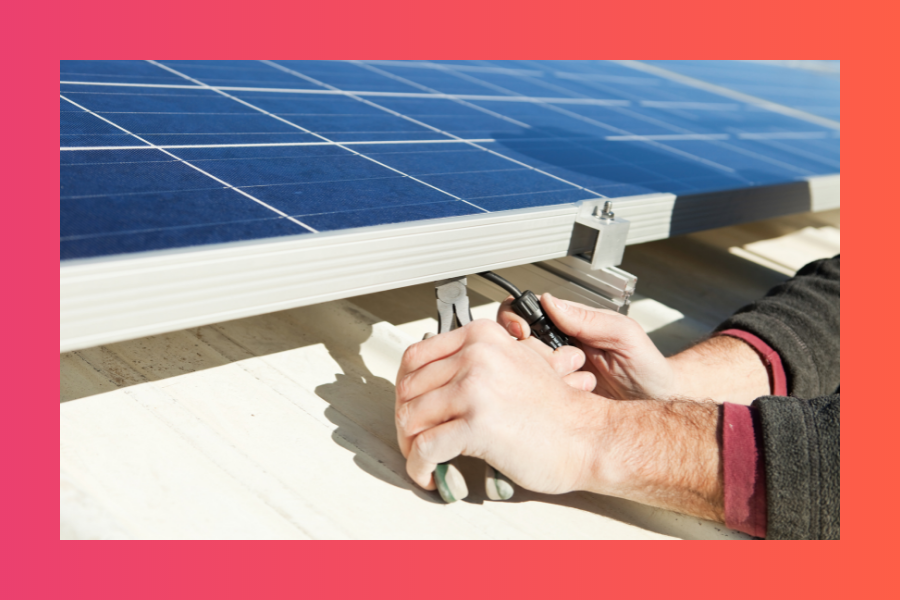Australian Electricity Prices Go Up, Rooftop Solar Prices Go Down
High electricity prices have driven an uptake on rooftop solar with orders and installations at their 2nd highest levels as reported by news.com.au.
7 min read
![]() Solar Trust Centre Team
:
Jun 1, 2022 9:00:00 AM
Solar Trust Centre Team
:
Jun 1, 2022 9:00:00 AM

The story of solar power’s growth in Australia is truly terrific. Indeed, when considered in its full context - surrounding just how rapid and widespread its growth has been across the nation overall - it’s fair to say it’s been absolutely phenomenal. Yes, in terms of potential, the Great Southern Land was always a leading candidate globally for solar power’s growth, but even experts who looked at it in-depth just a little before this era of ‘renewable revolution’ kicked off have been surprised by the speed and scale of its rise throughout the 2010s and these early 2020s.
Over the past year, Australia passed the milestone of 3 million rooftop solar installations. This number is made all the more impressive when considered against our population - a little over 25 million - and the fact that it’s held there’s 10.6 million homes across the country. In turn, this growth clearly still has a long way to go. So let’s look back now at the path to 3 million rooftop solar installations in Oz - give them some context with some fun milestones as we do! - and also see what the latest data shows us about how we’re trekking towards 4 million.
A Snapshot of 2013
AFL Grand Final Winners: Hawthorn Hawks
NRL Grand Final Winners: Sydney Roosters A-League
Grand Final Winners: Central Coast Mariners
No. 1 ARIA Single: Katy Perry, Roar
No. 1 Film at the Box Office: Iron Man 3
In 2013 Australian solar reached the 1 million rooftop installation milestone. According to the Clean Energy Regulator, this figure was reached in March of that year. By this time, it’s held that more than 8000 people were working in the rooftop solar industry, and (as of the end of 2013) the nation had 3GW of solar capacity. Today, the country is a per capita world leader in terms of solar capacity, and after having passed the 1 million mark in 2013, momentum really began to pick up.
A Snapshot of 2014
AFL Grand Final Winners: West Coast Eagles
NRL Grand Final Winners: Sydney Roosters A-League
Grand Final Winners: Melbourne Victory
No. 1 Aria Single: 5 Seconds of Summer, Youngblood
No. 1 Film at the Box Office: Avengers: Infinity Wars
Depending on how you take the measurement, it can be said it indeed took a long time to get to 1 million solar panels. After all, the folks at Geoscience Australia say the land mass of Australia is up to 55 million years old, so if starting from that point it’s indeed taken a little bit to get to 1 million! But actually, (alongside the fact that it could also be said solar power really only began to have the potential to be a big commercial force in Australia from the 2000s onwards) what makes Australia’s solar story so special is perhaps not the time it took to get to 1 million - though that figure of course remains a remarkable achievement in its own right! - but how quickly the country doubled its capacity. It took just 5 years for the nation to go from 1 to 2 million rooftop solar panels. By December 2018 it was official.
A Snapshot of 2021
AFL Grand Final Winners: Melbourne Demons
NRL Grand Final Winners: Penrith Panthers A-League
Grand Final Winners: Melbourne City
No. 1 Aria Single: Glass Animals, Heat Waves
No. 1 Film at the Box Office: Spider Man: No Way Home
When it first started to become clear the outbreak of the Covid-19 pandemic abroad would pose a significant danger to the usual way of life once it reached Australia, there was huge uncertainty surrounding what impact it would have on the solar industry. Some felt solar professionals would perhaps be able to carry on ‘business as usual’ - thinking perhaps instead that it’d just be indoor-based businesses like cafes and restaurants which would be required to shut - whereas others felt this would mean solar businesses all across the nation would have to close for a significant period of time.
In most places, the truth was somewhere in-between, and rules differed across the nation from one state or territory to the next. Nonetheless, you’d have surely have been hard-pressed in the earliest days of the pandemic to find many solar professionals who felt an exciting new chapter of installations was just kicking off, and yet in a nutshell that’s exactly what happened. By November of 2021, news emerged we had officially hit 3 million installations. Unquestionably, challenges like lockdowns and supply chain disruption were hurdles to this growth between early 2020 and late 2021, but there was also a significant silver lining to the pandemic. Many people who shifted from the office to a work-from-home arrangement recognised solar could help them (alongside its many other benefits) save costs on their electricity bill; an expense that in so many cases had grown notably higher due to more demand on household electricity during business hours. Accordingly, this was a key driver in the spike in rooftop solar system sales, even amidst very challenging industry conditions.
Data from the 2021 calendar year (as distinct from the Australian financial year which runs from July to June) and 2022’s calendar year thus far, provides a clear-cut insight into Australia’s progress towards 4 million rooftop solar systems, after having hit the 3 million milestone. It’s held over 360,000 solar panels were installed across Australian rooftops during 2021. As a result, were the Australian solar sector to continue along at this pace - and those bullish on that possibility would also point to the very strong performance year by year before 2021 as well - with 350,000+ installations done a year, then by 2024 Australia should be well and truly beyond 4 million.
It must be noted that it was only in 2021 that we ticked over 3 million - so part of last year’s figures would not be counted in the 3 million plus range - but it’s also the case new stats surrounding new installations can take up to 12 months to come in. So, while officially it was only in November 2021 we hit 3 million according to the data, in fact the time at which the number of solar systems on Australian rooftops actually exceeded 3 million likely occurred much earlier in the year. As a result, it could be expected that the growth beyond 3 million rooftop solar systems in Australia - given the above factors and the significant passage of time between November 2021 and this month of June 2022 - is indeed well underway.
This said, although the march towards 4 million will be one with real momentum behind it, it’s of course necessary to also note that solar businesses across Australia have (like so many other industries) had to reckon with challenges in the global supply chain in recent times, alongside other factors related to Covid-19, such as the need for employees who’ve caught the pandemic virus to isolate for a multiple days at home, and thus potentially leaving their solar team short-staffed until the isolation period ends. The fact the national solar capacity has continued to grow well is testament to the capabilities of these businesses. Specifically, in them being able to by and large maintain a smooth operation even amidst these challenges. But of course were a major shock to the supply chain to occur in the near future - e.g. the outbreak of another conflict akin to that of Ukraine - it’s a reality that this shock could dramatically disrupt (even more) business as usual in the global market, and that could be expected to throw a whole ton of new hurdles in the movement towards 4 million.
Overall though, the fact the Australian solar industry has done so well in taking on the challenges of Covid-19 and still find a way to move forward very successfully augurs well for the future. Given the industry has by and large come through well all the upheaval of the pandemic in recent years, means there is every reason to have confidence in its resilience in the years ahead, whatever challenges may await it down the line.
As our readers will know, Australia’s federal government recently changed. The STC team has discussed elsewhere in-depth the results of the 21 May 2022 election, and in turn how the outcome of that vote is set to inform the national conversation surrounding renewables and action on climate change going forward. It’d be beyond the scope of this article to revisit these areas now at length, but there is indeed a key aspect here that is essential to note. The fact is until this election, government credit for the growth of solar power in Australia could largely be attributed to state governments - but with a change of government nationally has come the prospect for a nationwide change here too.
For the majority of the past ten years, the Coalition had control over the federal government, and enthusiasm for renewables (alongside action on climate change) was very low within it. Now there is the Labor Party in government led by Prime Minister Anthony Albanese. In turn, there’s been a substantial increase in people sent to Parliament from outside Labor and the Coalition, as seen with the election of new Greens politicians, as well as the teal independents.
These newcomers have been sent with strong mandates from their electorates to take action on climate change. At present it’s early days in the life of this new government and Australian Parliament, and the precise direction Australia is set to go now is still taking shape. Nonetheless, there’s no doubt much stronger support at the national level for renewables can be expected on this side of the election result, as opposed to before it. This is a source of great promise for the nation as Australia’s rooftop solar capacity seeks to push towards 4 million, and then 5 and 6 million after it!
Just as solar power enthusiasts in Australia certainly look forward to the country hitting 4 million before long, it’s important to not overlook the colossal achievement that is hitting 3 million rooftop solar installations. As discussed above, certainly government policy is important in encouraging this progress, but at the end of the day taking up solar power is voluntary, and so the greatest credit for this achievement resides not with politicians, but instead with regular Australians who sought to get a rooftop solar system of their own.
There are many reasons that entice a would-be solar owner to get rooftop solar - be it a system’s ability to drive down electricity costs, provide a defence against them rising in future, and of course the capacity for a rooftop solar system to make a small, but significant contribution to creating a cleaner and green world - yet whatever precisely drives the push to acquire a solar system, each of them installed so far have helped Australia reach a milestone of which all should rightfully be very proud of. Not only because achieving a milestone level of rooftop solar bolsters our national renewable energy capacity, but also because of the potential of rooftop solar to help address other challenges we face, such as by making use of rooftop solar combined with community batteries to help provide power at a lower price to households who are yet to have solar, and find themselves struggling to keep up with the cost of living right now.
For these reasons and more, if there’s an interest in rooftop solar power but up until this point it has not been looked into in-depth, then it can be said there’s indeed never been a better time to start than right now! Best of all, there’s a ton of resources right here to continue on with, whether it be learning about how to look for a quality solar installer, to discussing all the benefits a rooftop solar system combined with other smart home devices can bring to a property. What’s more, if there’s really keen passion for solar power growing right now, a review of The Science Behind Self-Healing Solar Panels will also be fun, to get a glimpse at what the future of solar power innovation is set to look like in time ahead, as Australia continues to march towards 4 million rooftop solar installations and beyond!

High electricity prices have driven an uptake on rooftop solar with orders and installations at their 2nd highest levels as reported by news.com.au.

1. How Long Until 4 Million? Charting Aussie Solar Power Growth After Officially Hitting 3 Million Installations The story of solar power’s growth in...
Charles Sturt University (CSU) in Southern New South Wales has installed the largest rooftop solar power system. The solar power system consists of...